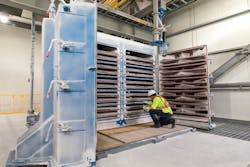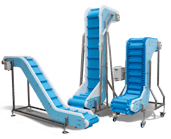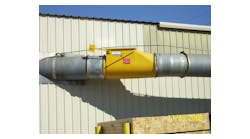Q&A: Strategies for optimizing the efficiency of industrial screening systems
Director, Global Market Development
Rotex Global, LLC
Scott Haley has 23 years’ experience in industrial screening and size classification both as an independent representative for Rotex Global, LLC, and working directly for the company as director of global market development. Haley earned a bachelor’s degree in ceramic engineering from Clemson University.
On Thursday, Dec. 14, 2017, Haley will lead a Processing webinar, “Best practices for auditing the performance of your screening process” (2 PM, ET). During this Rotex-sponsored webinar, attendees will learn best practices for evaluating the quality and efficiency of industrial screening processes, as well key reasons you should consider evaluating your screening process today, including:
- You could be producing out of spec material.
- You could be losing money to your "out of spec" material.
- Your screener might be hiding additional capacity you are unaware of.
- Production feeds constantly change, and you may no longer be screening what you thought you were.
- Ensure total optimization of your screening process.
The Processing team recently sat down with Haley to ask a few questions and provide a taste for what will be covered during the webinar.
What are some of the key considerations industrial organizations should be mindful of when specifying screening equipment?
As with all process equipment, there are important considerations to keep in mind when specifying screening equipment. Some of the key considerations include the following:
- Capacity: Typically expressed in Lbs/Hr or Tons/Hr, the capacity is something that needs to be understood when sizing screening equipment. Clarification should be made if the capacity is actually the desired finished product capacity, or simply the incoming feed to the screening equipment. If the former, the total incoming feed to the screening equipment will be dependent on the amount of available product in the incoming feed distribution and the recovery efficiency of the screening equipment.
- Separation requirements: The required separations that the screening equipment is being specified to make should be identified. The separations are typically determined by the finished product specifications and may vary dependent on the type of screening motion, angle of inclination, operating speed and screening media being used.
- Separation quality: The separation quality is defined by the finished product specifications. This is commonly expressed in terms of a target particle size or particle size range with a specified amount of allowable "off-spec" material in the finished product.For example, a finished product may be defined as a “4.0 mm x 2.0 mm particle size with maximum 3.0 percent particles larger than 4.0 mm and 5.0 pecent particles finer than 2.0 mm.” This description defines the separation quality required with established limits for oversize and undersize particles in the finished product. The quality can also be expressed in terms of mesh size with reference to the U.S. mesh or Tyler mesh test sieve standards.
- Incoming particle size distribution: The particle size distribution of the incoming feed to the screening equipment is another important consideration. In general, the higher the percentage of available product in the incoming feed, the more efficient the screening equipment should be at meeting the separation quality. Conversely, the less the available product, the more challenging the separation can become and the greater the importance of separation efficiency.
- Downstream processing: The downstream processing of the off-spec particle fractions should also be kept in mind. If the off-spec fractions are part of a closed recycle loop with the screening equipment, the screening efficiency will have an impact. An example of this is a two-deck screening circuit where the oversize fraction is sent to a size reduction stage and then returned to the screening circuit and the fines fraction is discarded. If the screening equipment is not properly sized to include the recycle, poor separation efficiency will result, causing more "on-spec" particles to be tailed over with the off-spec oversize fraction. When these product sized particles pass through the size reduction stage, they may return to the screening circuit as off-spec fines and end up being discarded.
What are the common pitfalls users typically encounter when specifying, operating and/or maintaining screening systems?
One of the common pitfalls users can encounter in screening systems is a tendency to focus only on analysis of the finished product fraction coming out of the screening equipment instead of analyzing the complete screening circuit. It is understandable that there is emphasis on analysis of the finished product since it must be in specification prior to shipment. The pitfall is that having the finished product in specification does not necessarily mean that the screening circuit is operating at optimal efficiency. Conducting an analysis of the incoming feed distribution and/or the off-spec fractions in addition to the finished product will enable a complete picture of the screening circuit efficiency to be determined and help to identify potential opportunities to increase finished product yield.
What are the typical causes of screening inefficiency?
There are several factors that can contribute to screening inefficiency. Some of the more common ones include the following:
- Varying feed characteristics: Incoming materials that are subject to changes in their physical characteristics, such as particle shape, moisture content, static properties, etc., whether naturally occurring or due to process variations, can impact the efficiency of screening equipment.
- Changes in feed distribution: Variations in the incoming particle size distribution of the feed to the screening equipment, as previously mentioned, can have a notable impact on screening efficiency. The particle size distribution may change due to natural variations in the incoming feed or changes due to process conditions. Changes that result in less available product in the feed or that significantly increase the amount of "near-size" particles (particles that are very close in size to the openings of the separation media) can increase separation inefficiency.
- Blinding or pegging of the screen clothing/media: Particles that lodge in the openings of the screen clothing or separation media, commonly referred to as "blinding" or "pegging" in screening jargon, reduce the number of openings available for separation. If uncontrolled, the reduction in open screen area will continue to increase and the screening equipment will lose efficiency.
- Overfeeding: Screening equipment is usually capable of handling a higher volume of material than the rated screening capacity. Users sometimes equate volume capacity with screening capacity and increase the feed rate to the screening equipment as a result. In these cases, an over-fed condition can occur increasing the material bed depth on the screen media and making the separation more inefficient.
What does a screening system audit entail and why is it a recommended best practice?
A screening system audit is an analysis of the separation performance of the screening equipment. Ideally, the audit will include a particle size analysis of the incoming feed material and separated fractions, and will confirm the fractional yields to get a complete picture of the screening equipment performance. The audit also includes a review of how the screening equipment is configured and what screen media is being utilized to make the separations. Additionally, the screening equipment’s mechanical condition and operation is checked to confirm it is being run as recommended by the manufacturer. Conducting an audit is a recommended best practice because, when it is completed, the audit should determine the separation efficiency of the screening circuit and identify any areas of inefficiency where improvements can be implemented to increase productivity.
What are some of the common outcomes of a screening system audit?
Some of the common outcomes of a screening system audit include:
- Increased finished product yield(s) from improved separation efficiency
- More efficient operation of equipment in downstream processes
- Reduced recycle volume in closed-loop circuits
- Potential savings in operating costs due to less reprocessing
- Improved mechanical operation from returning to the manufacturer’s recommended configuration
Why is it important for users of industrial screening technology to attend your upcoming webinar, "Best practices for auditing your screening process?"
Industrial processors are constantly challenged to find ways to improve operation efficiency, reduce costs, and increase productivity. For users of industrial screening technology, incremental gains in these areas may be realized by improving the separation efficiency of their screening equipment. An audit of the screening process is the first step in making that determination.
To learn more about how to improve the efficiency of industrial screening systems, register now for the webinar, “Best practices for auditing the performance of your screening process.”



